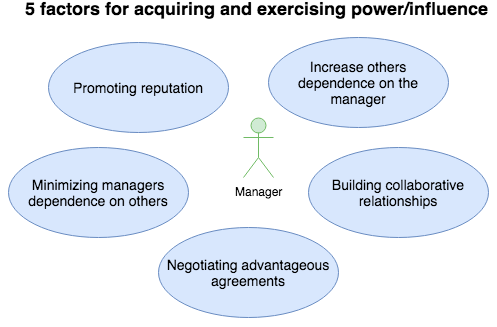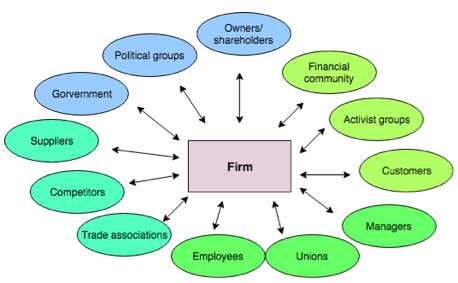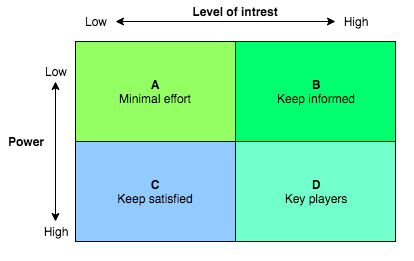Power, politics and stakeholder management
Contents |
Abstract
When managing any kind of project, programme or portfolio, different issues can occur that have an either positive or negative affect on the total outcome. These issues can be many different internal or external factors, as for example: the economy, natural incidents, people with specific agendas etc. An area of great importance with regard to these issues is stakeholder management, and how to navigate and handle different people, groups and organisations with relation to the project. “The ability of the project manager to correctly identify and manage these stakeholders in an appropriate manner can mean the difference between success and failure”.[1] Additionally managers will have to consider different key areas related to stakeholder management if this should be a success. The internal politics within organisations and the power and influence of stakeholders is crucial and should be considered with attention to specific factors.[2]
In this article stakeholders in relation to power and politics of different kind will be analysed and the classic stakeholder-mapping tool is presented as well as an assessment of power/influence in management.
The article comprises the following:
1. A description of when the stakeholder mapping is used and in the context it is applicable. Furthermore an explanation of how to acquire and exercising power/influence for management.
2. An applications guide of how to perform the stakeholder mapping.
3. A consideration of limitations within this topic.
Big idea
blablablablabla
Application
As stated in the previous section stakeholders or constituents are prone to behave in specific ways that can strengthen their power and ability to make desired outcomes happen. Therefore managers have to be alert with regard to this and identify important stakeholders, categorise them and analyse how to influence them, in order to achieve the desired success for the project. As a tool for this managing process, the stakeholder map can be used. A guide for how to use the tool will be presented below:
When performing a stakeholder analysis it is important to look at it as a systematically process. Here the manager has to gather and analyse both quantitative and qualitative data and information with regards to those who should be considered having an impact throughout the project. This analysis should identify the interests, expectations and influence of different stakeholders and try to determine how they relate to the project. Furthermore an identification of stakeholder relationships could be developed and used to determine a power/influence strategy as described in the ‘Big idea’ section.
1. The first step of the analysis is identification of the different stakeholders. This step is sometimes referred to as the ‘Stakeholder brainstorm’ and involves a process where all who is possibly affected or/and could affect the outcome of the project is identified. This identification process is done by using the previous mentioned data and information. To make sure that all relevant stakeholders have been taken into account in this first step, interviews with already identified stakeholders can be an option to ‘search the market’.
Above is an illustration of different stakeholders in a large organisation.[3] This show how the different groups, people or companies affect the firm leading the project, but on the other hand can also be affected by the project as mentioned in step 1. All these different stakeholders can be a big challenge, especially if the organisation handling the project is large, because many different groups will have conflicting interests and expectations. With this issue taken into account managers will have to analyse the power of the stakeholders.
2. The second stage of the analysis comprises of an assessment of impact or support from each of the different stakeholders. This assessment should be done by classifying all the identified parties with regards to how much power and influence they have on the specific project. This classification should be done by using the power/interest grid in which the manager will categorise the stakeholders “based on their level of authority (power) and their level of concern (interest) regarding the project outcomes”[4] and place them in the matrix as seen below.
Though it might seem fairly easy to do the categorisation of the stakeholders, difficulties in this process can occur.[5]
Two factors are of great importance when considering these difficulties:
• Individuals or organisations with known support of the project cannot be trusted because other groups or people within their organisation undermine their support.
• The second factor is with regards to assessing stakeholders with great power. There may be people or groups with a considerably big power connected to the project, but who has not exercised it in the past. This can be a risk if the stakeholder has drastically more power than expected or lately acquired the power to influence others but is handled inadequately by the manager.[6]
Limitations
Annotated bibliography
[1] The book gives an overview of how to identify, and plan for management of stakeholders, as well as manage and control engagement with stakeholders in relation to project management.
References
- ↑ Project Management Institute, A Guide to the Project Management Body of Knowledge (PMBOK® Guide), Fifth Edition, 2013
- ↑ Hayes J. The Theory And Practice Of Change Management, Fourth Edition, 2014
- ↑ Johnson G.,Whittington R., Scholes K., Angwin D., Regnér P. Fundamentals Of Strategy, Third Edition, 2015
- ↑ Project Management Institute, A Guide to the Project Management Body of Knowledge (PMBOK® Guide), Fifth Edition, 2013
- ↑ Hayes J. The Theory And Practice Of Change Management, Fourth Edition, 2014
- ↑ Hayes J. The Theory And Practice Of Change Management, Fourth Edition, 2014


